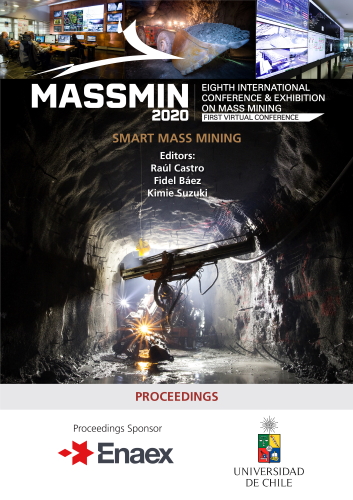Analysis of extraction level layouts for block caving

|
Authors: Gómez, RE; Saéz, K; Pino, N; Labbe, E; Marambio, E |
This paper is hosted with the kind permission of Lulea University of Technology, International Conference & Exhibition on Mass Mining, 2024.
DOI https://doi.org/10.36487/ACG_repo/2063_53
Cite As:
Gómez, RE, Saéz, K, Pino, N, Labbe, E & Marambio, E 2020, 'Analysis of extraction level layouts for block caving ', in R Castro, F Báez & K Suzuki (eds), MassMin 2020: Proceedings of the Eighth International Conference & Exhibition on Mass Mining, University of Chile, Santiago, pp. 773-786, https://doi.org/10.36487/ACG_repo/2063_53
Abstract:
Designs for extraction level layouts used in block caving mines may vary in terms of geometrical configuration and dimensions. The design of the extraction level in caving mines is mainly based on maximizing ore recovery at a low cost under safe and stable conditions. In this paper, we analysed the extraction level layouts commonly used as well as variations proposed with a specific focus on stability and productivity. The El Teniente layout was used as a base case with dimensions of 15 × 17.32 m2, production and extraction drifts of 4.3 × 3.6 m2, LHD of 7 yd3 and a productivity of 3,000 tpd per production drift. This base case was compared with three layouts: the Herringbone layout, a modified, enlarged El Teniente layout, and a modified, enlarged Square layout. Productivity was analysed through stochastic simulations using the software Arena; stability analysis used Examine3D software. Results indicated that in the new proposed layouts−the modified El Teniente layout and the modified Square layout−productivity increased by 33% and 39%, respectively, whereas the cycle time decreased by 23% and 25% with regards to the base case. In terms of stability, the Herringbone layout had the best safety conditions on the walls of the production and extraction drifts, whereas the modified, enlarged El Teniente layout had the best safety conditions on the roofs of the production drift. Finally, it is concluded that the modified layouts can contribute to increasing ore recovery while decreasing the cyle time without sacrificing stability.
References:
Aimin, Z & Yongxue, S 2000, ‘Application of block caving system in the Tongkuangyu Copper Mine’, in G Chitombo (ed.), Proceedings of MassMin 2000, Australian Institute of Mining and Metallurgy, Melbourne, Australia, pp. 325-334.
Aguayo, A, Campos, C, Mansilla, M, Sougarret, J & Susaeta, A 2004, ‘LHD versus mechanized grizzly in III Panel of Andina’, Proceedings of MassMin 2004, Santiago, Chil, pp. 415-520.
Arce, JC 2002, ‘Drawpoint spacing, production and undercut level design for panel caving mehtod ini primary rock’, El teniente, Bachelor Degree, Universidad de Santiago de Chile, Santiago, in Spanish.
Brzovic, A & Villaescusa, E 2007, ‘Rock mass characterization and assessment of block-forming geological discontinuities during caving of primary copper ore at the El Teniente mine, Chile’, Int J Rock Mech Min Sc, vol. 44, no. 4, pp. 565–583.
Bull, G, Macsporran, G & Baird, C 2004, ‘The alternate design considered for the Argyle underground mine’, in A Karzulovic & M Alfaro (eds), Proceedings of Massmin 2004, Santiago, pp. 616-622.
Catalan, A, Dunstan, G, Morgan, M, Green, S, Jorquera, M & Thornhill, T 2012, ‘An “intensive” preconditioning methodology developed for the Cadia East panel cave project, NSW, Australia’, Proceedings of MassMin 2012, Canadian Institute of Mining, Metallurgy and Petroleum, Westmount.
Capes, G, Sharrock, G & Lowther, R 2012, ‘Methodology for Understanding Drive Deformation and Damage in Variable Rock Types in a High Stress, Advanced Undercut’, Proceedings of MassMin 2012, Canadian Institute of Mining, Metallurgy and Petroleum, Westmount.
Chacon, J, Gopfert, H & Ovalle, A 2004, ‘Thirty years evolution of block caving in Chile’, Proceedings of Massmin 2004, A Karzulovic & M Alfaro (eds), Santiago, pp. 387-92.
Chacón, J 1976, ‘Block Caving and LHD – Extraction layouts thought’, Revista Minerales, vol. 134, in Spanish.
Chitombo, DG 2010. ‘Caving mining – 16 years after Laubscher’s 1994 paper: Cave mining – state of the art’, in Second International Symposium on Block and Sublevel Caving, ed. Y Potvin, Perth, pp. 45-62.
Codelco 2016, ‘T14 E200: mining of Reservas Norte, El Teniente’. (Pre-feasibility study, Internal report), in Spanish.
Flores, G, Karzulovic, A & Brown, ET 2004, ‘Current practices and trends in cave mining’, in A Karzulovic & M Alfaro (eds), Proceedings of Massmin 2004, Santiago, pp. 83-90.
Hannweg, L, Lorig, L, van Hourt, G & Guest, A 2004, ‘Koffiefontein mine front cave - Case History’, in A Karzulovic & M Alfaro (eds), Proceedings of Massmin 2004, Santiago, pp. 225-30.
Hersant, D 2004, ‘Mine design of the Argyle underground project’, in A Karzulovic & M Alfaro (eds), Proceedings of Massmin 2004, Santiago, pp. 610-615.
Hurtado, JP, Pereira J & Campos R 2007, ‘Final report - Fragmentation Backanalysis: Diablo Regimiento mine, Reno mine and Teniente 4 Sur Tonalita mine. (Pre-feasibility study, Internal report), in Spanish.
Jofre, J, Yáñez, P & Ferguson, G 2000, ‘Evolution in Panel Caving Undercutting and Drawbell Excavation, El Teniente Mine’, in G Chitombo (ed.), Proceedings of MassMin 2000, Australian Institute of Mining and Metallurgy, Melbourne, Australia, pp. 249-260.
Laubscher, DH 2000, ‘Horizontal LHD layouts’, in Block cave manual, Julius Kruttschnitt Mineral Research Centre, Brisbane.
Rech, W 2001, ‘Henderson mine’, in Underground Mining Methods, ed/s. W. Hustrulid, R. Bullock, pp. 397-453.
Rocscience 1994, ‘User Manual Examine 3D’.
Ross, I 2008, ‘Northparkes E26 Lift 2 block cave – A case study’, in 5th International Conference & Exhibition on Mass Mining, Lulea, pp. 25-34.
Sepúlveda, DN 2017, ‘Geological fault characterization based on critical variables and shear strength estimations, El Teniente mine’, PhD Thesis, University of Concepción, Chile, in Spanish.
Wellmann, F 2001, ‘Extraction layout selection: Isla LHD Project, Report PL-I-158/2001’, in Spanish.
Yuming, L & Jinfeng, Z 2008, ‘Tongkuangyu mine’s phase 2 project’, in 5th International Conference & Exhibition on Mass Mining, Lulea, pp. 53-61.
© Copyright 2025, Australian Centre for Geomechanics (ACG), The University of Western Australia. All rights reserved.
View copyright/legal information
Please direct any queries or error reports to repository-acg@uwa.edu.au
View copyright/legal information
Please direct any queries or error reports to repository-acg@uwa.edu.au
